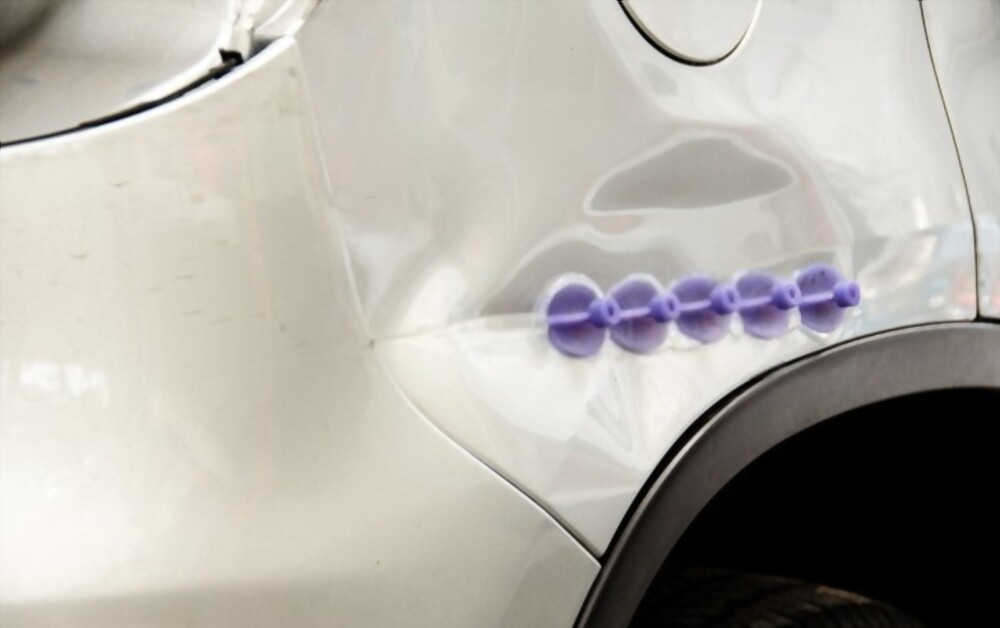You love your car and care for it regularly by washing and waxing. You have also got some paint for touch-ups and applied on chips and scratches when you spot them. Of late, you notice some small areas on the front bumper and hood where the paint is starting to peel off. It makes you worried.
Even when taking good care, some factors can usually cause paint peeling or delamination. This peeling or delamination will ultimately reduce your vehicle’s curb appeal and resale value if it remains unchecked. Consult paintless dent repair near Louisville KY.
What Are The Causes Of Car Paint Delamination?
Before we go into the causes of delamination, it’s essential to know about car painting basics.
The Basics of Car Paint
Vehicles have finishes made by several layers, which include
- Primer
Primer serves as the base layer for the paint, assists with paint adhesion, and provides a reliable surface for extra coats while protecting the metal underneath. - Base Coat
Several automotive paint layers are carefully applied at the manufacturing unit to give the base coat its unique coloration and appearance. - Clear Coat
This final layer provides a hardcover that protects the paint from oxidation or corrosion, minor chips and scratches, and other environmental factors over the years. It preserves the appearance of the original factory paint.
Reasons for Car Paint Peeling Off
Coming back to delamination, irrespective of when you have bought your car, the elements can wreak havoc with surface shine. Below we take a look at the two main reasons why paint peeling occurs.
1 Irregular Base
As mentioned earlier, it is the base preparation that goes into a car paint job. The first and most associated reason with large-scale paint delamination is improper preparation of the painted surface. All the big names in car manufacturers have had paint problems due to changes in painting processes. The changes fail the primer, paint, or clear coat.
And an irregular base leads to delamination or peeling.
2 A Patchy Paint Seal
The second significant reason for delamination is when the clear coat, base coat, and primer seal are weakened by a deep chip, ding, or scratch. Once that happens, moisture, road salt, and other pollutants begin their work through coatings to cause peeling.
Even a small chip in the clear coat can cause severe peeling. It happens when the area is exposed to more external forces such as high-pressure washing or direct sunlight.
Ways to Protect the Paint on Your Vehicle
No doubt, vehicles have a clear coat paint finish. This means that your car has base paint with a thick clear coat of paint that seals and protects the car’s paint. The clear resin applied to the vehicle gives a beautiful color. The resin finish also protects your car from the elements that damage UV rays.
Car owners find that the clear coat finish prevents all damage from the sun. This is partially true. You can follow some steps to help your paint keep your vehicle new for a long time.
1 Apply A Sealant:
Use a sealant at least once or twice a year. It will safeguard your car paint by adding a protective layer over it.
Take a bonding agent with the sealant and mix them. Mix half a cup of sealant to one tablespoon of the agent. The amount may vary according to the size and structure of your vehicle. It is important to maintain a ratio of 4: 1 of sealant and bonding agent.
2 Use Car Cover
Covers are the easiest and simplest way to protect your car’s paint. Use a good quality car cover and limit the sun’s harmful UV effect. When parking, you can just put on the car cover and save your car paint and engine at once.
Remember, never cover a wet car as it produces bacteria and fungus. Never keep the car cover in the sun, nor keep your car covered for a week to protect your car from damage.
3 Park Your Vehicle in a Covered Structure
Sun rays can fade the color of your car over time. Parking in a covered structure can help your vehicle avoid this kind of damage. Covered parking structures protect your car from tree sap and bird droppings which can discolor your vehicle.
4 Wash and Dry
Washing your car can significantly reduce the harmful effects of UV rays and remove all accumulated dust, dirt, and grime that can damage your car’s exterior finish. Use a gentle automotive cleaner and a clean cotton cloth. Avoid harsh chemicals that can ruin the exterior finish. Wipe off excess moisture
5 Do a Wax Polish
Waxing the car improves the brightness of the clear coating and looks brand new. And it acts as a protective layer against UV rays, bird droppings, and bug splatters. Additionally, it reduces the drag force applied to your car, increasing its efficiency. The wax can clean, protected, and polish all at once.
6 Synthetic Coating for Extra Protection
Synthetic coating or ceramic coating is a liquid polymer coat applied to a car’s exterior to prevent paint from fading due to continuous exposure to harmful UV rays. Additionally, it prevents stains, builds scratch resistance, and makes your car water-resistant. It also protects your car from tree sap and bug splatter.
7 Get a Perfect Car Wash
Some car washes use brushes, and some have cloth. The tools can act like sandpaper and damage the paint surface if the brush or cloth is dirty with sand. Ensure that the car wash is clean and well maintained. Take a closer look at the brush. Dirt may accumulate in them if nylon threads are brittle or torn.
The above are a few ways to protect your car paint.
To Conclude
The best way to protect the paint on your vehicle is to discuss your requirements with the expert professionals at Glaser’s Collision Centers.

